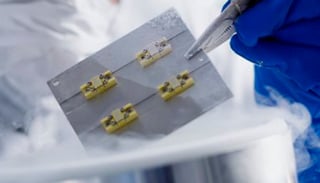In military applications, the reliability of a laser diode can be a literal matter of life-or-death. Functionality is critical regardless of setting. Laser diode modules that create first light within high-energy lasers, such as those used within advanced targeting systems and directed energy weapons, face particularly brutal requirements. The environment within such lasers is often more extreme than the exterior environment. For military-grade laser diodes, there are four primary environmental considerations:

Operating temperature range: Defense-related high-energy lasers may see deployment in any number of physical locations. The range of possible temperatures interior and exterior to the high-energy laser means that the internal laser diodes must operate over a broad temperature range. Leonardo laser diodes perform reliably at temperatures as high as 130°C down to cryogenic temperatures as low as 140K. Individual components have performed at temperatures as low as 77K.
Thermal shock and cycling: Laser diodes may experience thermal shock resulting from rapid deployment into an operating environment. Furthermore, the interior of a high-energy laser is not a thermally stable environment, particularly in pulsed mode, when the laser diode pump modules are subject to rapid heating and cooling cycles. Rapid temperature cycling generates thermal stress due to differences in the coefficient of thermal expansion among various materials in the assembly. Diode performance under such stress depends on selecting proper materials and managing the interfaces between those materials. Leonardo diodes perform reliably across a range of pulse frequencies, from 1Hz “hard pulse” conditions to KHz frequencies. At those laser pulse frequencies, Leonardo laser diodes have demonstrated survival through thousands of temperature cycles over the temperature range -40°C to +100°C at ramp rates up to 220°C/min.
Storage temperature range: Diodes must maintain their performance over long periods of storage, such as within inactive equipment and during shipping. In defense applications, the storage temperature ranges can be quite extreme. Leonardo diodes remain reliable when stored at temperatures as low as -60°C and as high as +100°C.
Mechanical ruggedness: For mobile systems, the diode arrays must withstand mechanical vibrations and shock. Because of Leonardo's patented assembly processes, Leonardo diodes are particularly rugged. Leonardo diodes have demonstrated the capability to withstand complex shock and vibration profiles ranging from assault rifles, such as the M4A1, to large artillery, such as the M777 Howitzer.
Leonardo Diode Extreme Environment Test Results
|
Test Category |
Test Condition |
|
Thermal Shock |
-30°C to +70°C, 200 cycles, 220°C/minute |
|
Thermal Cycling |
-40°C to +100°C, 6,000 cycles, 220°C/min |
|
High Temperature Storage |
+100°C |
|
Low Temperature Storage |
-60°C |
|
High Temperature Operation |
80°C |
|
Low Temperature Operation |
140K |
|
Uncontrolled Operation |
-40°C to +85°C |
|
Mechanical Vibration |
50g sine, 38grms random 10Hz-2,000Hz |
|
Mechanical Shock |
5,000 rounds mounted to M4A1 assault rifle |
|
5,000g; 2,000 rounds M777 Howitzer |
Download our white paper for more on laser diode pump sources for directed energy.
For more on laser diode care, check out Five Sources of CW Laser Diode Failure and How to Prevent Them.

